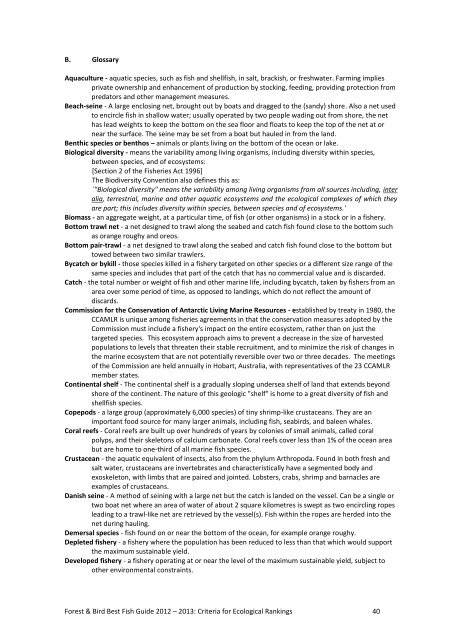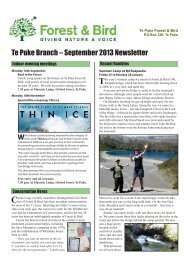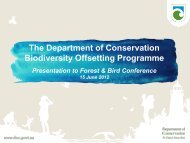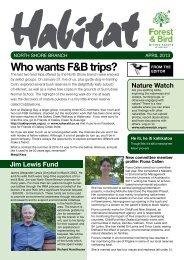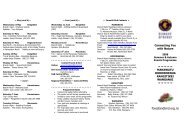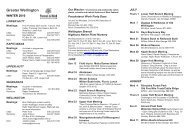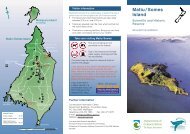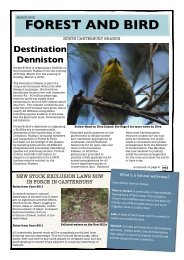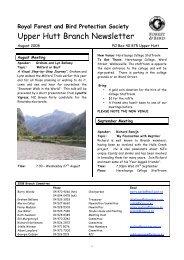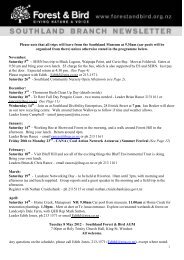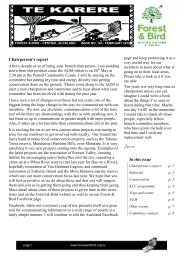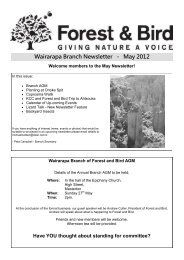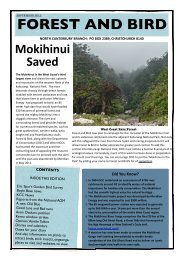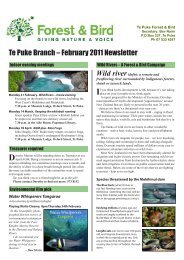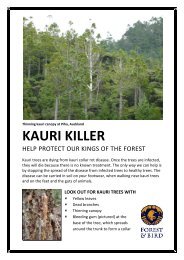methodology - Forest and Bird
methodology - Forest and Bird
methodology - Forest and Bird
You also want an ePaper? Increase the reach of your titles
YUMPU automatically turns print PDFs into web optimized ePapers that Google loves.
B. Glossary<br />
Aquaculture - aquatic species, such as fish <strong>and</strong> shellfish, in salt, brackish, or freshwater. Farming implies<br />
private ownership <strong>and</strong> enhancement of production by stocking, feeding, providing protection from<br />
predators <strong>and</strong> other management measures.<br />
Beach-seine - A large enclosing net, brought out by boats <strong>and</strong> dragged to the (s<strong>and</strong>y) shore. Also a net used<br />
to encircle fish in shallow water; usually operated by two people wading out from shore, the net<br />
has lead weights to keep the bottom on the sea floor <strong>and</strong> floats to keep the top of the net at or<br />
near the surface. The seine may be set from a boat but hauled in from the l<strong>and</strong>.<br />
Benthic species or benthos – animals or plants living on the bottom of the ocean or lake.<br />
Biological diversity - means the variability among living organisms, including diversity within species,<br />
between species, <strong>and</strong> of ecosystems:<br />
[Section 2 of the Fisheries Act 1996]<br />
The Biodiversity Convention also defines this as:<br />
`"Biological diversity" means the variability among living organisms from all sources including, inter<br />
alia, terrestrial, marine <strong>and</strong> other aquatic ecosystems <strong>and</strong> the ecological complexes of which they<br />
are part; this includes diversity within species, between species <strong>and</strong> of ecosystems.'<br />
Biomass - an aggregate weight, at a particular time, of fish (or other organisms) in a stock or in a fishery.<br />
Bottom trawl net - a net designed to trawl along the seabed <strong>and</strong> catch fish found close to the bottom such<br />
as orange roughy <strong>and</strong> oreos.<br />
Bottom pair-trawl - a net designed to trawl along the seabed <strong>and</strong> catch fish found close to the bottom but<br />
towed between two similar trawlers.<br />
Bycatch or bykill - those species killed in a fishery targeted on other species or a different size range of the<br />
same species <strong>and</strong> includes that part of the catch that has no commercial value <strong>and</strong> is discarded.<br />
Catch - the total number or weight of fish <strong>and</strong> other marine life, including bycatch, taken by fishers from an<br />
area over some period of time, as opposed to l<strong>and</strong>ings, which do not reflect the amount of<br />
discards.<br />
Commission for the Conservation of Antarctic Living Marine Resources - established by treaty in 1980, the<br />
CCAMLR is unique among fisheries agreements in that the conservation measures adopted by the<br />
Commission must include a fishery's impact on the entire ecosystem, rather than on just the<br />
targeted species. This ecosystem approach aims to prevent a decrease in the size of harvested<br />
populations to levels that threaten their stable recruitment, <strong>and</strong> to minimize the risk of changes in<br />
the marine ecosystem that are not potentially reversible over two or three decades. The meetings<br />
of the Commission are held annually in Hobart, Australia, with representatives of the 23 CCAMLR<br />
member states.<br />
Continental shelf - The continental shelf is a gradually sloping undersea shelf of l<strong>and</strong> that extends beyond<br />
shore of the continent. The nature of this geologic "shelf" is home to a great diversity of fish <strong>and</strong><br />
shellfish species.<br />
Copepods - a large group (approximately 6,000 species) of tiny shrimp-like crustaceans. They are an<br />
important food source for many larger animals, including fish, seabirds, <strong>and</strong> baleen whales.<br />
Coral reefs - Coral reefs are built up over hundreds of years by colonies of small animals, called coral<br />
polyps, <strong>and</strong> their skeletons of calcium carbonate. Coral reefs cover less than 1% of the ocean area<br />
but are home to one-third of all marine fish species.<br />
Crustacean - the aquatic equivalent of insects, also from the phylum Arthropoda. Found in both fresh <strong>and</strong><br />
salt water, crustaceans are invertebrates <strong>and</strong> characteristically have a segmented body <strong>and</strong><br />
exoskeleton, with limbs that are paired <strong>and</strong> jointed. Lobsters, crabs, shrimp <strong>and</strong> barnacles are<br />
examples of crustaceans.<br />
Danish seine - A method of seining with a large net but the catch is l<strong>and</strong>ed on the vessel. Can be a single or<br />
two boat net where an area of water of about 2 square kilometres is swept as two encircling ropes<br />
leading to a trawl-like net are retrieved by the vessel(s). Fish within the ropes are herded into the<br />
net during hauling.<br />
Demersal species - fish found on or near the bottom of the ocean, for example orange roughy.<br />
Depleted fishery - a fishery where the population has been reduced to less than that which would support<br />
the maximum sustainable yield.<br />
Developed fishery - a fishery operating at or near the level of the maximum sustainable yield, subject to<br />
other environmental constraints.<br />
<strong>Forest</strong> & <strong>Bird</strong> Best Fish Guide 2012 – 2013: Criteria for Ecological Rankings 40


